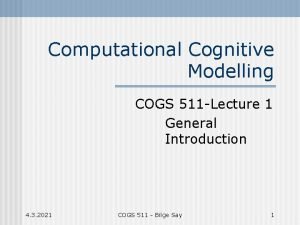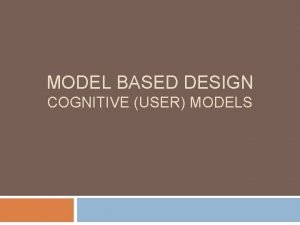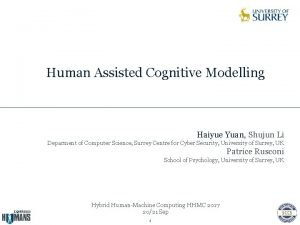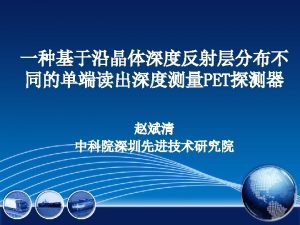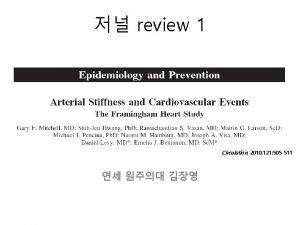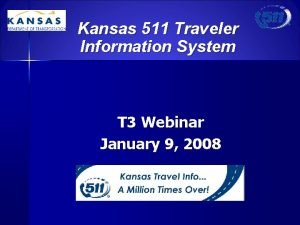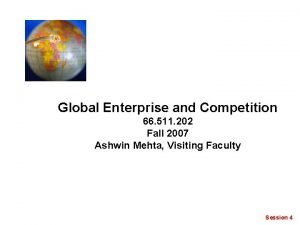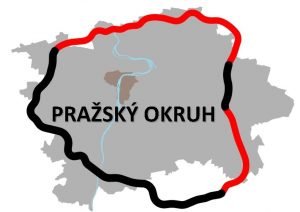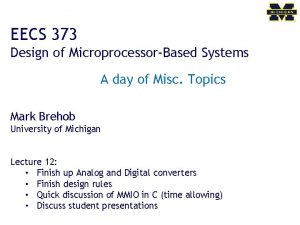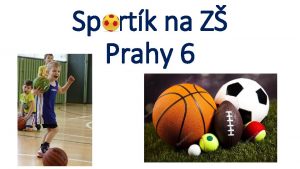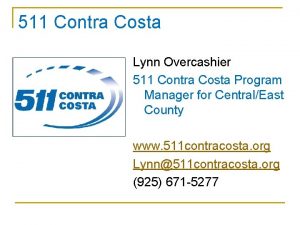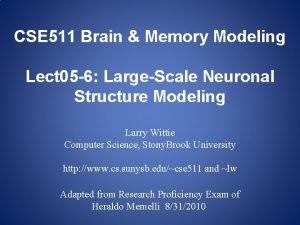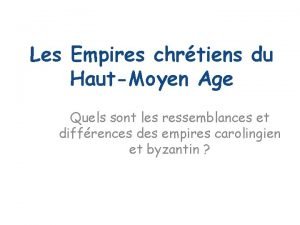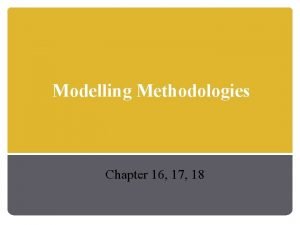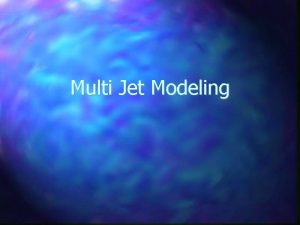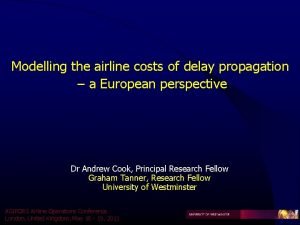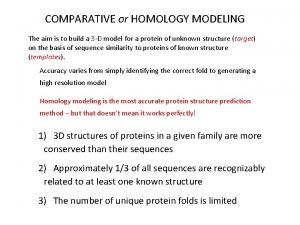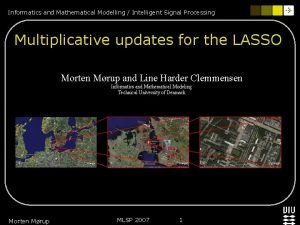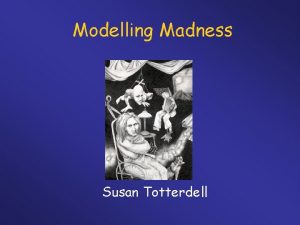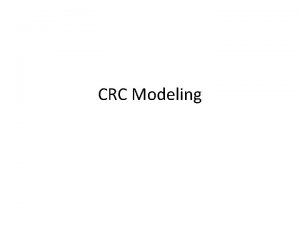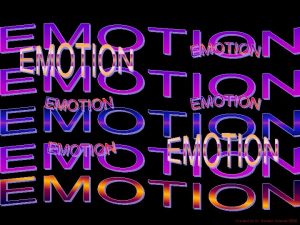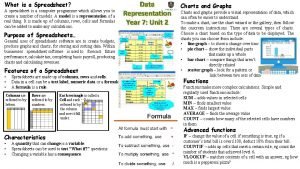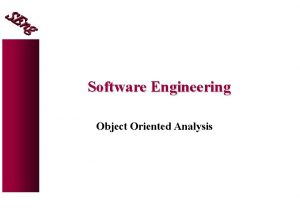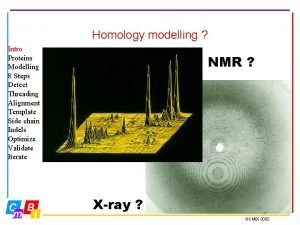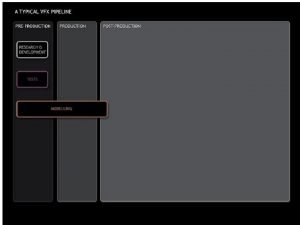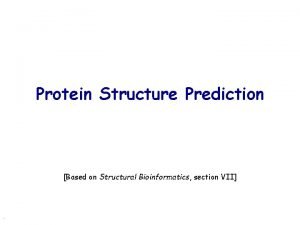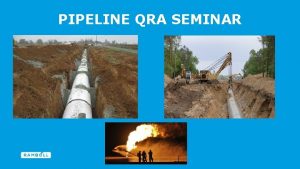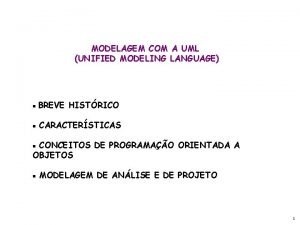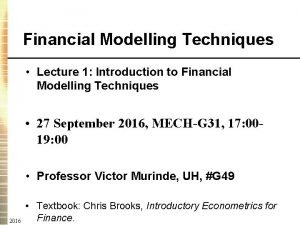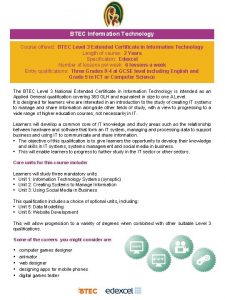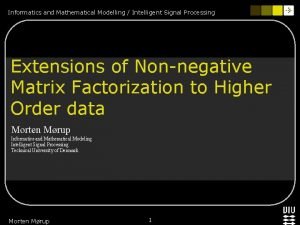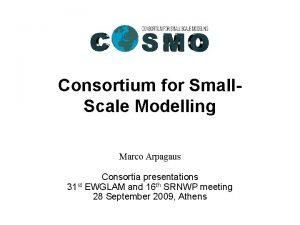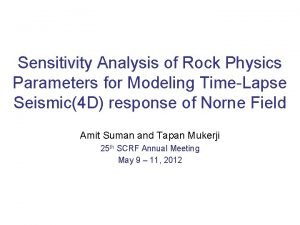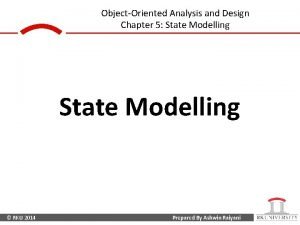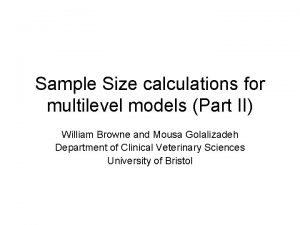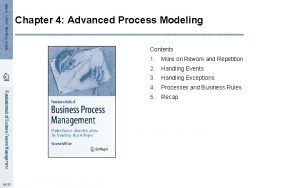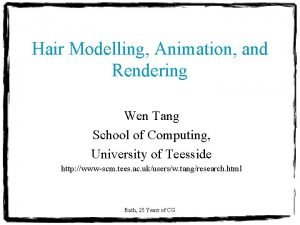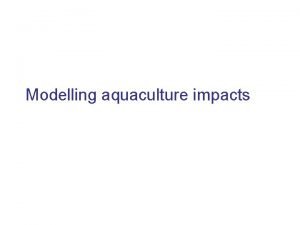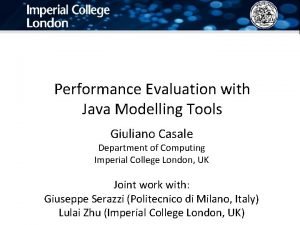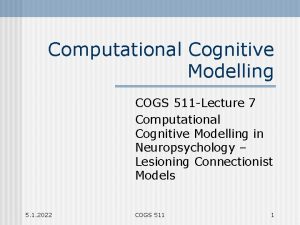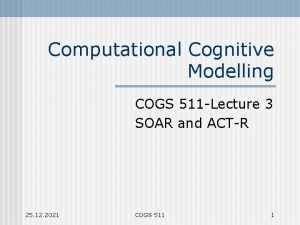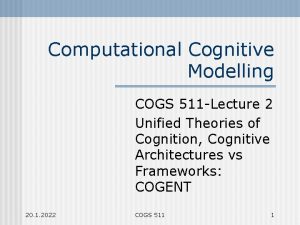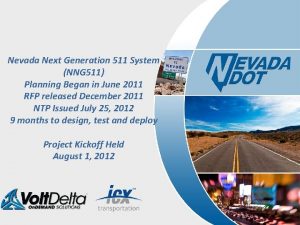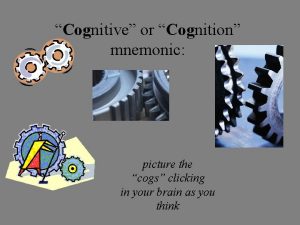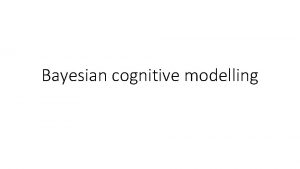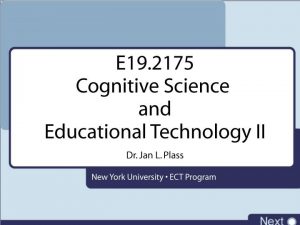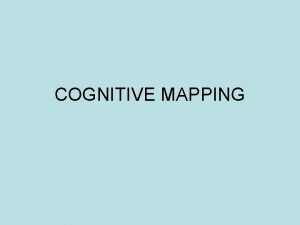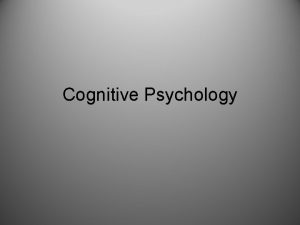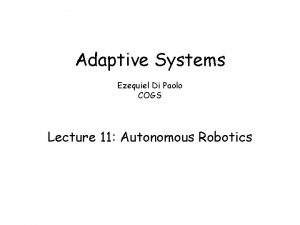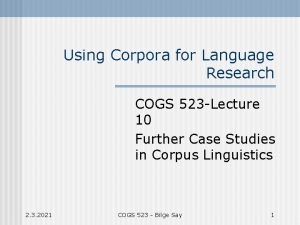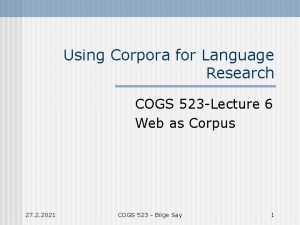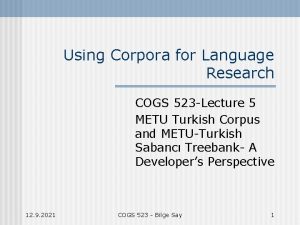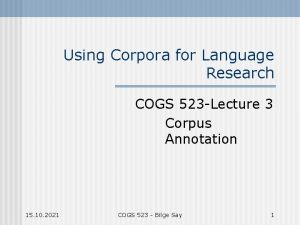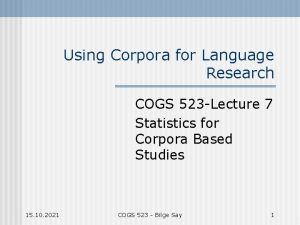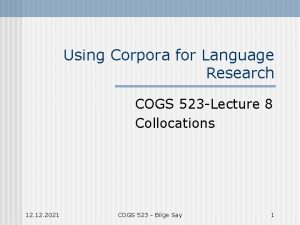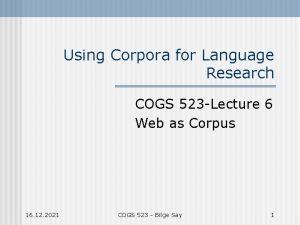Computational Cognitive Modelling COGS 511 Lecture 8 Computational



















































- Slides: 51

Computational Cognitive Modelling COGS 511 -Lecture 8 Computational Models of Analogy Making 15. 10. 2021 COGS 511 1

Related Readings: n Forbus et al. MAC/FAC: A Model of Similarity-Based Retrieval. Cognitive Science, 19. (1995) n Hummel and Holyoak, (1997) Distributed Representations of Structure, Psychological Review both in Polk and Seifert (2002) Optional and Further Readings n French (2002). The Computational Modeling of Analogy Making. Trends in Cognitive Sciences 6(5). n Gentner and Markman (2003). Analogy-Based Reasoning and Metaphor. In Arbib (ed). Handbook of Brain Theory and Neural Networks. n Salvucci and Anderson (2001). Integrating Analogical Mapping and General Problem Solving: the Path-mapping Theory. Cognitive Science 25, 67 -110. 15. 10. 2021 COGS 511 2

Analogy Making n n Mapping between two domains, a source (aka base) and a target based on the perceived relational commonalities between domains that might be dissimilar on the surface. Hall’s essentials: Recognition (Retrieval) of a source, given a target description n Establishment, elaboration and evaluation of the mapping between the two n Transfer of information from source to target n Consolidation (i. e. learning) of the outcome: generalizing from specific cases; developing general mental schemata (other processes suggested: dynamic representation building) n 15. 10. 2021 COGS 511 3

Benchmark Phenomena of Analogy-Experimental Evidence n n Relational Similarity: Alignment of Relational Structure; ex: The atom is like the solar system Structured Pattern Matching n n Parallel connectivity: matching relations have matching arguments One-to-one correspondence: The same item in the base can not be aligned with multiple items in the target or vice versa. Systematicity: Analogies seek connected systems of matching relations rather than isolated relational matches Candidate Inferences: Analogical inferences are generated via structural completion 15. 10. 2021 COGS 511 4

Benchmark Phenomena of Analogy n n Alignable Differences: Corresponding but nonidentical differences are considered to be more salient; e. g. atoms have electrons and solar systems have planets (an alignable difference). Solar systems have asteroids, atoms do not (nonalignable difference) Flexibility in Interactive Interpretation n n Flexibility in Multiple Interpretations n n The same item can take part in many comparisons, with different aspects of the representation participating in each comparison, e. g. US politics in Iraq: World War 2 or Vietnam? (different bases) “A lake is a mirror” vs “Meditation is a mirror” (different targets) Multiple Interpretations of the Same Comparison- structural consistency: Cameras are like tape recorders Cross-mapping n Object similarities suggest different correspondences than do relational similarities; people can compute both alignments and depending on the features available can prefer one over another. 15. 10. 2021 COGS 511 5

Symbolic Models n Early Models (1960 s): n n n Argus (Reitman)- proportional analogies by conceptual networks: bear: pig; chair: ? (foot, table, coffee, strawberry) ANALOGY (Evans)– proportional analogies on the domain of geometric figures; able to build high level representations from low level descriptions of the figure and discover rules. Structure Mapping Theory (SMT) (Gentner, 1983) n n Emphasis on structural (relational) similarity and systematicity for mapping and making inferences Structural Mapping Engine (SME) – computational implementation of SMT MAC/FAC model of analogical retrieval intended to be coupled with SME as a frontend. Later SME-based models such as SEQL (Kuehne, 2000) applied to infant categorization. 15. 10. 2021 COGS 511 6

Connectionist Models n ACME (Holyoak and Thagard, 1989): n n STAR (Halford, 1994; Wilson 2001) n n localist, constraint-satisfaction network, where structural and semantic similarity and pragmatic importance (being related to goals, preknown mappings) determine the constraints that help consistent nodes to become active. ARCS is a model of retrieval for ACME where retrieval is dominated by semantic similarity. STAR-1: distributed connectionist model for proportional analogies; based on tensor products. STAR-2 has been used to model children’s analogy making capabilities. DRAMA (Eliasmith and Thagard, 2001); Adaptive Resonance Theory- based analogy making (Jani and Levine, 2000) 15. 10. 2021 COGS 511 7

Hybrid Models n COPYCAT and related architectures (TABLETOP, METACAT) (Hofstadter, 1984, 1995): n n COPYCAT solves letter-string proportional analogies and has working memory, long term memory and a procedural memory of nondeterministic, parallel working codelets. AMBR (Kokinov, 1994; Kokinov and Petrov 2001): n Solves problems by analogy on a cognitive architecture called DUAL that is based on parallel, interacting, context-sensitive hybrid microagents. 15. 10. 2021 COGS 511 8

Metaphors and Analogy n n n Metaphors are nonliteral assertions of likeness: “A cloud is like a sponge” or “A cloud is a sponge”. Novel metaphors are processed similarly to analogies but they need not be based on relations, e. g. above metaphor can be interpreted on a attribute of a sponge, fluffiness. Conventional metaphors (e. g. Some people are sheep) are more likely to be interpreted as class inclusions. Metaphors can carry an emotional aspect rather than having explanatory-predictive functions as analogies. Few computational models of metaphor see Budiu and Anderson (2000, 2002); Narayanan (1999). 15. 10. 2021 COGS 511 9

MAC/FAC: A Model of Similarity Based Retrieval n Models of analogical retrieval should be able to explain the fact that remindings are often based on surface similarities, whereas mapping and transfer on structural similarity n n Experiments on “Karla the Hawk” stories about memory access and subjective soundness (how well inferences could be carried from one story to another). Focus on n Accessing a similar base situation Creating a mapping from the base to the target Evaluating the mapping 15. 10. 2021 COGS 511 10

MAC/FAC model n n n Two stage model; MAC stage using a computationaly cheap but non-structural filter; FAC stage a more expensive but more accurate structural match among items from the MAC output. Input: pool of memory items and a probe (target) Output: an item from the memory and a comparison with the probe Each stage has parallel matchers and a selector 15. 10. 2021 COGS 511 11

(Forbus et. al, 1995) 15. 10. 2021 COGS 511 12

The FAC Stage n n Based on Structure-Mapping Engine (SME), which has already been tested to be consistent with psychological evidence. Computing a set of global interpretations, each of which has n n n A set of correspondences A structural evaluation A set of candidate inferences Sensitive to both attributes and relations Selector returns upto 3 very close matches. 15. 10. 2021 COGS 511 13

The MAC Stage n n Selector similar to FAC Stage Matchers are based on content vectors, special type of feature vectors denoting how many times each functor from the domain of functors (relations, attributes, etc) occur in a given description. Each memory item has a content vector stored with it; each probes content vector calculated and compared with existing ones. Similarity with connectionist frameworks 15. 10. 2021 COGS 511 14

Cognitive Simulation Experiments n n n n Variations on Karla the Hawk stories Psychological Experiments: 20 base stories, 12 distractors, and 5*4 probe stories- variations classified into Literal Similarity (LS), analogy (AN), Surface Similarity (SF), Common First Order Relation –mostly events (FOR); subjects are asked to write down stories that are reminded to them with probes. Computational Simulations: 9 stories with 4 variants for each, encoded in predicate logic. 9 distractors. Three variations of simulations Same qualitative ordering of stories that pass the MAC/FAC stages: LS>SF>AN>FOR as in human subjects FAC accepts nearly half of MAC outputs. Sensitivity Analysis of the Model to different factors in the model n n n Not sensitive to normalization procedure for content vectors Content vectors must include both attributes and relational information Not sensitive to selector widths within a reasonable range 15. 10. 2021 COGS 511 15

15. 10. 2021 COGS 511 (Forbus et. al, 1995) 16

(Forbus et. al, 1995) 15. 10. 2021 COGS 511 17

Comparative Evaluation n Comparison with ARCS, localist connectionist, constraint satisfaction analogy retrieval (Thagard et al. ) n n n No user-marked pragmatic effects in MAC/FAC No cheap, initial estimation in ARCS Different similarity metrics, no special status to relational similarity in ACME and ARCS, where lexical similarity is calculated via Word. Net. MAC/FAC can operate on ARCS datasets with similar results but not vice versa. ARCS exhibits at least two reversals of the ordinal order in Karla the Hawk stories 15. 10. 2021 COGS 511 18

Discussion n n n No Modeling of Retrieval Failure or Decay No Explicit Effect of Goal Structures MAC stage, psychologically plausible? Feeling-ofknowing studies Scaling up content vectors More between-item and iterative processing as avenues for development Able to accommodate e. g. expert-novice differences in analogy Needs to be embedded in larger performance models 15. 10. 2021 COGS 511 19

Empirical Phenomena for evaluation of Models (Hummel and Holyoak, 97) n Access and its Relationship to Mapping n n n Semantic Similarity has greater impact than in mapping Isomorphism has less impact than in mapping Close analog and schema easier to access than far analog Access is competitive Familiar anolog accessed more readily 15. 10. 2021 COGS 511 20

Empirical Phenomena for evaluation of Models (Hummel and Holyoak, 97) n Analogical Mapping n n n n Isomorphism Semantic Similarity Pragmatic Centrality Multiple Possible Mappings for One Analog Correct Initial Correspondence Facilitates Subsequent Mappings Difficulty finding mapping for unnatural analogy problems Possible to map predicates with different number of arguments 15. 10. 2021 COGS 511 21

LISA (Learning and Inference with Schemas and Analogies) n n Structure-sensitive connectionist model Dynamic Binding: Units representing case roles are temporally bound to fillers of these roles. Semantic Units in LTM; semantic similarity by dot product of vectors corresponding to a concept Units which fire in synchrony are bound together; they fire out of synchrony otherwise n n Has limited working memory capacity: possible to have 4 -6 simultaneously active but mutually out of synchrony groups One level restriction: can not deal with embedding well or different role bindings Neuroscientifically plausible ? ? Performs similar to human analogical reasoning 15. 10. 2021 COGS 511 22

15. 10. 2021 COGS 511 Hummel and Holyoak (1997) 23

15. 10. 2021 COGS 511 Hummel and Holyoak (1997) 24

15. 10. 2021 COGS 511 Hummel and Holyoak (1997) 25

LISA (Learning and Inference with Schemas and Analogies) n n Drivers: Either base or target chosen as a driver; role-argument binding in driver activates distributed semantic representation and in turn localist concept nodes in the other domain. Working memory allows role binding of higher order relations preceding role bindings of their arguments allow correspondences of those higher order relations to affect the correspondences for arguments 15. 10. 2021 COGS 511 26

Probability Problem n n n Based on Permutation-Combination problems given to College students Eg. Assigning Cars to Mechanics for repair of Assigning Computers to Students to Study First +/-: similarity of story line Second +/-: similarity of roles and animacy (humans/artifacts) 0 -neutral Semantic similarity positively influences analogical mapping – similar objects, similar roles Semantic similarity negatively influences analogical mapping-similar objects different roles 15. 10. 2021 COGS 511 27

Hummel and Holyoak (1997) 15. 10. 2021 COGS 511 28

Soap Opera Experiments and Model n n Pragmatic Centrality: Pragmatic focus affects mapping Two similar soap opera plots: romantic, professional, cheating relations Plot extension and Mapping task CP: Consistent w. Pragmatic Emphasis; IP: Inconsistent w. Pragmatic Emphasis; CC: Consistent w. Cheating; IC: Inconsistent w. Cheating 15. 10. 2021 COGS 511 29

15. 10. 2021 COGS 511 Hummel and Holyoak (1997) 30

Pragmatic Centrality on Ambiguous Maps n n Two science fiction stories – economic and military relations Planet P 1 n n n Richer(Aflu, Barebrute) Stronger(Barebrute, Compak) Planet P 2 Richer(Grainwell, Hungerall) n Stronger(Millpower, Mightless) Barebrute is ambiguous in mappings n 15. 10. 2021 COGS 511 31

15. 10. 2021 COGS 511 Hummel and Holyoak(1997) 32

Main Results n n n Structurally consistent relational mappings Cross-mappings possible One interpretation at a run but varience possible wrt activation order of nodes in the driver (this is decided by the modeler, though) Scaling up ? ? Cannot make inferences Coarse qualitative and quantitative evaluation metrics 15. 10. 2021 COGS 511 33

Path-mapping Theory (Salvucci and Anderson) n n Integrating Analogical Mapping and General Problem Solving Understanding Analogy within a General Theory of Cognition, i. e. ACT-R Finer fitness with quantitative criteria (latency, correctness) than other theories of analogical mapping Accounting for lower level behaviour such as typing and eye movements and incorporating incremental mapping 15. 10. 2021 COGS 511 34

Components of the Theory n Representation n Analogies (analogs) • Objects • Relations • Roles: higher order conceptual structures linking objects and relations • Pointer to parent relation and its type • Pointer to child relation/object and its type • The relation the object fills in the relation Eg. The object ss-sun serves the center role in the relation ss-revolves 15. 10. 2021 COGS 511 35

Path Mapping n n Path Mapping maps a single source object to a single target object by finding analogous paths between objects and their highest order parent relations (i. e. root relations). Implemented as a set of production rules (7 productions + additional productions in different models) Different analogical mapping tasks will interleave path mapping with different organizational knowledge. Alternative paths may exist, but only one chosen at a time. Further mapping does not go up to root level, can take shortcuts. 15. 10. 2021 COGS 511 36

Related Parameters Chunk Activations n Chunk Mismatches: degree to which chunks are dissimilar. n Production Matches and Utilities n 15. 10. 2021 COGS 511 37

15. 10. 2021 COGS 511 Salvucci and Anderson (2001) 38

Accounting for Existing Lit. 15. 10. 2021 COGS 511 Salvucci and Anderson (2001) 39

PP: Probability Problem Values in parantheses-model predictions 15. 10. 2021 COGS 511 Salvucci and Anderson (2001) 40

PP 1000 simulations; R=0. 93 n 5 common parameters (either estimated or preset through all models) + one additional parameter for miscelloneous error (0. 36? ) n Additional productions – setting the mapping subgoal and producing additional errors n 15. 10. 2021 COGS 511 41

SO: Soap Opera 1000 simulations, R=0. 98, additional parameter for emphasized chunks, five additional productions 15. 10. 2021 COGS 511 Salvucci and Anderson (2001) 42

AM: Attribute Mapping R=0. 97 15. 10. 2021 COGS 511 43

Ordering and No of Similar Attributes Affects Ease of Mapping n n n Bill is intelligent. Bill is tall. Tom is timid. Tom is tall. Steve is intelligent. n n n Fido is clever. Blackie is friendly. Blackie is frisky. Rover is clever. Rover is friendly. (singleton) 15. 10. 2021 COGS 511 44

Other Models Sharing (Sh) n Country Mapping (CM) n Karla the Hawk Stories (KH) n No quantitative fits given. . . 15. 10. 2021 COGS 511 45

Story Mapping n n n Experiments and Modelling Collection and Modelling of Eye Tracking and Typing Data (for pressing three keys required. Key-time ratios) Two stories; mapping task; study and mapping phases One story (source story was removed during the mapping) vs two-story conditions Significant effects of both adjacency and condition. (Adjacency effect is present in one story condition and also effects mapping time) 15. 10. 2021 COGS 511 46

Model for Story Mapping 15. 10. 2021 COGS 511 Salvucci and Anderson (2001) 47

15. 10. 2021 COGS 511 Salvucci and Anderson (2001) 48

Results and Discussion “Excellent” qualitative and quantitative fits with experimental data. Eye movement and typing times: how fitted not explained; 8 additional parameters. n Modelling both incremental nature of analogical mapping and the effects of memory access and adjacency on mapping success. n 15. 10. 2021 COGS 511 49

Overall Evaluation Different effects and processes within a single phenomena n Value of qualitative fits (? ) n Value for hybrid models n 15. 10. 2021 COGS 511 50

Lecture 9 n Next week: Computational Models of Consciousness – Maia and Cleeramans 15. 10. 2021 COGS 511 51
 Income statement beginning inventory
Income statement beginning inventory Cognitive modelling
Cognitive modelling Cognitive modelling
Cognitive modelling Cognitive modelling
Cognitive modelling Cognitive and non cognitive religious language
Cognitive and non cognitive religious language 01:640:244 lecture notes - lecture 15: plat, idah, farad
01:640:244 lecture notes - lecture 15: plat, idah, farad Pet 511 kev
Pet 511 kev Circulation 511
Circulation 511 Adw 511
Adw 511 Kansas 511 road conditions
Kansas 511 road conditions 511
511 Stavba 511
Stavba 511 Eecs 511
Eecs 511 Rta goroo
Rta goroo Sokp 511
Sokp 511 511 contra costa
511 contra costa Cse 511
Cse 511 Royaume de clovis en 511
Royaume de clovis en 511 Data modelling methodologies
Data modelling methodologies Multi jet modelling
Multi jet modelling Modelling rich interaction
Modelling rich interaction Modelling cost of delay
Modelling cost of delay Homology modelling steps
Homology modelling steps Modelling
Modelling Modelling madness
Modelling madness Crc modelling
Crc modelling Sd3 security framework
Sd3 security framework Malatesta's modelling e.g. by mother
Malatesta's modelling e.g. by mother What is spreadsheet
What is spreadsheet Climate based daylight modelling
Climate based daylight modelling Class responsibility collaborator modelling
Class responsibility collaborator modelling Uml overview
Uml overview Homology modelling steps
Homology modelling steps Modelling
Modelling Energy based model
Energy based model Pipeline risk assessment software
Pipeline risk assessment software Language
Language Types of financial modelling techniques
Types of financial modelling techniques Unit 5 data modelling assignment 2
Unit 5 data modelling assignment 2 Power platform data modelling
Power platform data modelling Modelling rich interaction
Modelling rich interaction Modelling
Modelling Modelling
Modelling Modelling relationships and trends in data
Modelling relationships and trends in data Rock physics modelling
Rock physics modelling State modelling
State modelling Mlpowsim
Mlpowsim Advanced process modelling
Advanced process modelling Chloe ashford
Chloe ashford Hair modelling
Hair modelling Mom modelling
Mom modelling Java modelling tools
Java modelling tools

